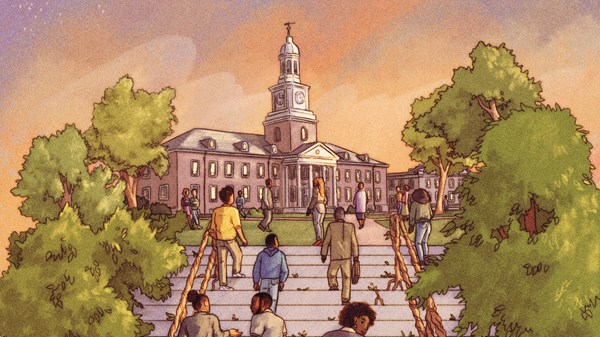At Cleveland, Tennessee’s Lee University, Mykah Smith stands inside a silent, candlelit circle of peers, professors, and administrators. A Bahamian graduate student, she relays her own pain to the group: “I was not black until I came to America.” Smith is one of three students of color speaking at Lee’s Vigil for Racial Solidarity.
Several months after the 2017 Unite the Right rally in Charlottesville, Virginia, a small group of Lee professors planned the vigil as way of inviting members of the university community to stand together in solidarity against racism with their brothers and sisters of color.
Over 700 attendees sang along with a gospel choir and listened to administrators advocate for inclusion. Theology student Franco Crosby, one of the event’s speakers, described being followed by local police officers one evening after a resident reported him for looking suspicious as he walked across campus in his hoodie. The event had a profound effect: In the days following the vigil, speaker Charity Parris said she found herself “in more racially conscious conversations with professors and students of all backgrounds.”
Making progress on racial issues is a challenging process—one to which faculty and staff must remain faithfully committed. For instance, Lee has a racial justice advocacy group and hosts various events to educate students about diversity and anti-racism work, but if that work is not ongoing and evolving, it cannot be effective. At these institutions the largest strides are usually taken after the photographer packs up and the event is over; consistency and commitment cannot be overvalued. As with most institutions in the Council for Christian Colleges and Universities (CCCU), the students of color at Lee are a minority group faced with the challenge of negotiating a predominantly white space.
When faculty and staff are sensitive to the challenges faced by students of color, they contribute to the greater goal of creating communities that honor the image of God in his diverse creation. Institutions like Calvin College and Azusa Pacific University have long embraced these aims as part of their comprehensive mission. But no matter the institution’s history, much work is still ahead of us—especially if the fight for racial reconciliation is to become more than a trend, but rather a good faith effort to right past wrongs and to shape a new culture of genuine diversity. According to Jacque Fields, former assistant dean of multicultural student development at Calvin College in Grand Rapids, Michigan, when we are dealing with racial and cultural bias and even outright injustice, “You never stop. It’s like your grass. You cut it, and it grows back. People think it is over. It’s never over.”
Thankfully, though, several colleges have identified places to start.
Becoming Students Again
Unlearn Week. Fields, along with Dean Michelle Lloyd-Paige, founded this week-long program at Calvin College. “Making the invisible visible,” the slogan for Calvin’s multicultural student advisory board, threads the events together. It is also a way Fields brings to light the underlying reality of racial bias: “It’s like The Matrix. You are operating in a system that is invisible to you, and you are feeding it energy completely unbeknownst to you. Once I can show you how the matrix is at work, you see it everywhere.”
While at Calvin, Fields became especially passionate about equipping “all offices on campus to think about what it means to reflect the Kingdom of God in our student body and faculty body.” By serving on almost every committee and sharing her perspective as a woman of color, Fields undertook a mass educational effort for faculty, staff, the president, and the president’s cabinet. Unlearn Week now continues under the guidance of Dr. Christina Edmondson, dean for intercultural student development.
Unlearn Week encourages participants to identify preexisting patterns and presuppositions while seeking accurate information to unseat these assumptions. Showcasing this value, Azusa Pacific University (APU) in Azusa, California, has a growing center dedicated to training faculty and staff on diversity, equity, and inclusive excellence as they strive to enrich “the cultural proficiency of faculty, staff, and students to ensure that every member of the APU community is respected, successful, and thrives.” While APU’s center could begin and end with theory, it prioritizes practice. “As a Christian university, we have a moral imperative for inclusion and for equipping students to live in a diverse world,” Dr. Richard Martinez, executive director of the center, explains. “If we don’t do this, it’s the Lord’s kingdom that suffers.” APU’s center provides a diversity ambassador program that first began with 13 faculty and staff but now trains over 80 people. APU is investing in the education of their students by investing in their educators, teaching through a narrative curriculum how to create to a campus culture that is more creative, inclusive, flexible, and respectful.
These efforts to train faculty and staff were already in place, according to Warren, but they gained traction after a group of student activists staged a protest, walking out during the APU president’s chapel address. The protestors, who called themselves Activate, had three demands: 1) faculty and staff diversity training, 2) a clear bias incident reporting system, and 3) sufficient financial support for ethnic organizations. Feedback later collected from student surveys revealed a deep need for the very changes the protesters were wanting; they were a mouthpiece for the concerns of many. The administration listened to the protestors and student body, and now APU has one of the most extensive diversity training programs in the CCCU.
When faculty and administrators listen to the concerns of students of color, as was done at APU, campuses—and hope—thrive. Lee student Indyasia Fowler felt isolated and unheard during a class discussion on the Confederate flag when her professor argued that taking down the flag was unnecessary because it was simply a symbol of family pride and heritage. Days before, the same professor had mentioned he felt anxious and afraid when driving through predominantly black low-income areas. Seeing her opportunity to make a connection, Fowler commented in class that her professor’s feeling of fear in driving through those neighborhoods was exactly how she felt when encountering the flag, but her argument did not elicit much response. Several weeks later, Fowler’s professor approached her, apologizing for his remarks in class. After watching Selma and seeing Martin Luther King, Jr. lead a march over the Edmund Pettis Bridge while it was framed by Confederate flags, the professor said he now understood why his words were so hurtful. Fowler was comforted by his confession: “I felt really hopeful.”
As in Fowler’s case, the support of professors proves to be just as important for students as that of their peers. However, a lack of encouragement can be detrimental to a student’s success. “Some professors were far from culturally competent,” Candace Thornton says of her time at two Christian colleges. “They downplayed the struggle of African Americans.” Thornton did encounter some faculty and staff, though, who expressed a willingness to embrace her culture as they “pushed me to be myself.”
Brandon Fleming, a graduate of Liberty University in Lynchburg, Virginia, spoke of the impact of his English professors Dr. Karen Prior and Dr. Matthew Towles who introduced him to literature that told the stories of his own heritage. They “did not expect me, as a young black man, to adapt to the white conservative profile at my predominantly white institution.” When professors are able to listen to and uniquely support students of color, it radically changes their educational experiences.
Redefining We
It is hard for students to feel seen and supported if they are not included in the college’s vision and purpose, explains Dr. Linda Naranjo-Huebl, associate professor of English at Calvin College. A formative moment for Naranjo-Huebl was when one of her white students shared an interaction she had with another Calvin professor. Upon asking the professor why the class was reading only Anglo-American and European authors, he responded, “Because that’s who we are.”
“What’s embedded in that statement is the idea that the we is what the institution is, that’s what our identity is, so in one moment that comment reflected how those from different cultural backgrounds are not included in the we,” says Naranjo-Huebl.
Shania Rogers, a recent graduate of Bryan College in Smithfield, Rhode Island, discusses the work still to be done as institutions strive to redefine we: “Racism does not disappear once you set foot on a Christian college campus—it is heightened. I have found out that once you step into an environment that wasn’t made for you, that environment will do everything in its power to make sure that you don’t belong.”
When students of color are intentionally integrated into a school’s vision, colleges and universities can successfully prioritize diversity through curriculum changes and special events. Education theory reveals that students perform better academically when they are taught about their own culture. Teaching multi-ethnic literature and history is not, however, only important for students of color. Naranjo-Huebl says that when her white students read African American and Native American history and literature, they are typically angry, feeling deceived by the historical narratives that have diminished these accounts. Discussing multi-ethnic texts in the classroom can create opportunities for difficult discussions while also providing a place for students of color to engage with literature that represents them for perhaps the first time.
Some Christian colleges have also focused on making the discussion of racial justice an integrative part of campus worship. This year, Covenant College combined their spring semester Day of Prayer with Martin Luther King, Jr. Day, drawing in a large cross-section of students, staff, and faculty, with the purpose of delivering one message: racial justice issues are Kingdom issues. The college’s chapel services have also had many speakers address social justice concerns. When diversity is prioritized as a core value, it will introduce change—from textbooks to song selections—and each of those choices is significant.
Steps Toward a New Future
Students of color are especially in need of support when they are victims of racial profiling, threats, or other forms of injustice, and administrators at Christian colleges are growing increasingly aware of their responsibilities during these times. Upon learning that the DACA recipients at Lee University were feeling anxious of their futures in the US, the former vice president of academics at Lee, Dr. Carolyn Dirksen, opened her home to offer support, hear their stories, and remain connected to the needs of these students. She also organized multiple campus-wide events so these students could share their experiences with others. Dirksen’s efforts not only provided a sense of security for the DACA students, but they also educated many on campus who were previously unaware of the plights of their peers.
One of the most exemplary administrative responses to on-campus racism was that from Calvin College president Dr. Michael K. Le Roy. In November 2015, two Calvin students drew swastikas and wrote “white power” in the snow on multiple cars in the college parking lot. Before those responsible had even been caught, Le Roy issued a statement on Facebook: “While we do not know the motive of those who did this, hateful acts such as these violate the image of God and dignity of all people, provide living proof of the sin and brokenness we experience in human community, and have no place at Calvin College.” In his post, Le Roy also challenged the campus community to ask the questions students of color were now facing: “How can I feel safe if someone casually uses these symbols? Did a follower of Jesus do this? If there is a Nazi on campus, am I safe here?” Le Roy then called a special chapel service, even closing campus offices, in order to pray, lament, and stand in support of the college’s students of color.
Intentional changes in curriculum and Facebook posts like Le Roy’s tell the same story: Christian colleges and universities that listen to students of color are creating inclusive and empowering communities. While good intentions are never enough, many of these institutions are pairing intentions with policy changes, hiring choices, and mandatory trainings, and students and faculty alike are experiencing the difference. APU’s president Jon R. Wallace encapsulates what some in the academy and in the church at large believe as we take stock of our failings, repent, and actively work to build something better: “We are not where we used to be, but we are certainly not where we want to be.”
The fight for racial reconciliation and justice is a long, often difficult path and is part of sanctification itself. We can find hope in the higher calling that unites Christian colleges and universities: the teachings and transformative power of Jesus Christ. Ephesians 2:14 says, “For he himself is our peace, who has made the two hopes one and has destroyed the barrier, the dividing wall of hostility.” With the help of the Holy Spirit, educators and students are equipped to do the work of Christ to destroy these barriers through prayer, education, humility, repentance, and confession. In doing this work, Christian campuses become flourishing communities and cultural influencers. So while we have hope, as Wallace said, there’s still much work to do. This attitude of honesty, perseverance, humility and hope, coupled with a trust in Christ that is the source of all these good things, is the way forward.
Mary McCampbell, PhD, is an associate professor of humanities at Lee University. She writes on the intersections of faith, contemporary fiction, and popular culture and is currently working on a book titled Postmodern Prophetic: The Religious Impulse in Contemporary Fiction.


